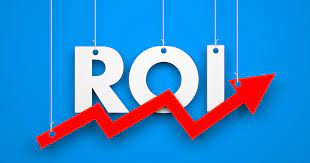In the world of social media marketing, although the internet made it much easier, understanding the complex language of ROI (Return on Investment) can be a challenging task sometimes for both marketers and businesses. It is crucial to understand how to measure the success of your social media efforts to guarantee that every dollar spent provides significant returns. Join us as we embark on a mission to simplify the process of calculating ROI in the digital world.
Our goal is to provide you with all the answers you need to refine your tactics and optimize your social media marketing. By the end of this journey, you will have the knowledge necessary to calculate your ROI and determine the effectiveness of your social media efforts, ultimately ensuring your success.
Navigating the ROI Conundrum
Social media has become a massive platform where billions of people share, like, and comment on endless digital content. However, one burning question that echoes stronger than ever in the big theatre of social media marketing is – how can we measure the ROI of our social media endeavors?
To answer this question, we need to understand the complicated balance of data, engagement, and conversions, rather than focusing solely on the numbers. It is crucial to first understand the importance of ROI and how it affects the course of our digital efforts before we set out on this journey.
Together, let’s overcome this confusing task and come away with a thorough understanding of how to accurately calculate the return on investment (ROI) for your social media marketing efforts.
Social Media ROI: Uncovering the Mysteries
In the context of social media marketing, what does ROI mean?
Return on Investment, or ROI, is the important indicator that evaluates how well your marketing initiatives performed with the resources used. In simpler terms, it answers the fundamental query: “Are the resources you’re investing in our social media campaigns producing visible results?” Understanding the ROI is the compass
That defines the strategies you use, whether your goal is to raise brand awareness, improve website traffic, or increase sales.
Understanding the ROI Calculation
Now that we understand what ROI is, let’s examine how to measure ROI in the context of social media marketing. ROI is mainly a calculation that calculates the net profit from your marketing efforts. Here is the equation:
ROI is equal to 100 times (Net Profit / Cost of Investment).
How can this formula be used in social media marketing?
To get an in-depth understanding there are certain terms you need to be aware of,
Net Profit: The money made as an outcome of your social media marketing efforts is generally referred to as the net profit. This includes overall sales revenue, lead-generating revenue, and any other tangible result.
Cost of Investment: Any expenses related to your social media efforts are included in the cost of investment. This covers expenses for tools, wages for employees, and content creation costs.
You could assess the outcome of your efforts by using this formula to calculate the effectiveness of your social media marketing efforts. A good ROI shows that your campaigns are generating returns on your investment that are higher than they were, whereas a negative ROI shows that improvements are required.
Setting Clear Goals
Setting specific and tangible goals for your social media campaigns is essential before you analyze any data. The goals you set will have an impact on the measurements you take to calculate ROI. Establishing certain goals enables you to match your approach with your desired results, whether your goal is to raise brand awareness, increase website traffic, or enhance sales.
Why are setting specific goals essential for calculating ROI? You may ask.
The basis of measuring success is to have clear objectives. When your goals are clear, you can monitor the exact metrics that are considered to be more significant to your company. For instance, you would concentrate on measures like click-through rates and visits to your website, if your objective was to boost more website traffic.
Social Media Offers a Range of ROI Metrics.
The success of your social media marketing efforts shouldn’t be measured solely by revenue generated from sales. There are other metrics that you should consider to determine the overall impact of your campaigns. Here are some key metrics that you should keep in mind:
Conversion Rate: This metric measures the percentage of users who take a desired action, such as making a purchase or signing up for a newsletter, after interacting with your social media content.
Click-Through Rate (CTR): CTR tracks the number of clicks on your social media posts or ads relative to the number of impressions. It indicates the effectiveness of your content in driving traffic to your website.
Engagement Rate: Engagement rate quantifies the level of interaction your content receives, including likes, comments, shares, and retweets. It reflects the extent to which your audience is actively participating with your brand.
Customer Lifetime Value (CLV): CLV estimates the long-term value of a customer, considering their repeated purchases and loyalty. Understanding CLV is crucial for assessing the long-term impact of your social media efforts.
Cost per Click (CPC) or Cost per Acquisition (CPA): These metrics help you evaluate the efficiency of your advertising campaigns by measuring the cost associated with each click or acquisition.
ROI Analytics and Tracking Tools
These monitoring tools can help you determine the ROI of your social media campaigns by providing you with valuable information about user behavior, engagement, and revenues. By analyzing this data, you can assess which strategies are working and which ones need improvement. This allows you to make better-informed decisions about your social media campaigns, which can help you improve your efforts and ultimately achieve greater ROI. Platforms like Google Analytics, Facebook Insights, and Instagram Insights are just a few examples of tools that can provide you with the data you need to make these informed decisions.
Using Attribution Models to Value Interactions
Calculating ROI in the world of social media marketing requires a clear understanding of attribution models. Attribution models assign value to the different interactions a user has with your brand before the conversion. The customer’s journey can be analyzed using various models, including first-click, last-click, or multi-touch attribution.
How can attribution models improve measuring ROI?
Attribution models assist you in assigning value to various touchpoints by taking into account the whole customer path to conversion. This enables you to understand how your social media efforts as a whole have affected the conversions.
ROI Optimization Strategies
Evaluating past performance is not the only requirement that needs to be improved for future campaigns. You need to gain insights from past performances and use them to enhance future campaigns. Here are a few effective strategies that can aid in boosting your social media ROI.
- A/B Testing: Experiment with different ad creatives, copy, and targeting options to determine what resonates best with your audience. Conducting A/B testing helps you to make your strategies better for achieving higher ROI.
- Audience Segmentation: Divide your audience into segments based on demographics, behavior, or preferences. Altering your content to each segment can result in more effective campaigns.
- Content Strategy: Investing in high-quality and engaging content that resonates with your audience can work wonders for you. Providing valuable content increases user engagement, which will eventually result in higher conversions.
- Budget Allocation: Strategically dividing up your budget is necessary. Focus on the platforms and campaigns that deliver the best ROI. Regularly assess and portion out your budget based on performance.
- Landing Page Optimization: Assuring your landing pages are optimized for conversions can make all the difference. Make sure to keep them simple, clear, and easy to navigate.
Conclusion
The struggle to perfect the skill of calculating ROI never ends. It takes a thorough understanding of your goals, a sharp eye for vital metrics, and the capacity to change or take your strategies according to the information you receive. so When you begin your journey on this road, keep in mind that ROI is not a static figure; rather, it is a representation of your efforts to engage with your audience, develop relationships, and ultimately produce significant results.
How can we sum up our journey across the social media ROI world?
You have to constantly alter your course of action, much like an experienced sailor sailing through rough seas. A positive ROI is more than just a goal; it’s a sign that you were able to understand the winds of social media, shape your sails, and make an effective course. It shows that you are committed to knowing your audience, providing value, and building relationships.
Therefore, conceive yourself with the skills, information, and motivation required to figure out the ROI conundrum. Understand the constantly changing nature of social media and take advantage of it. Access, analyze, grow, and then set out to sail once again because your quest for mastering the skill of ROI is an adventure with no bounds in this endless ocean of data as well as interactions.
As you learn new insights, you will continue to succeed and will be able to generate greater profits.






